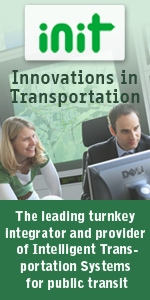

| In This Issue |
| » NEWS HEADLINES |
| » COVERAGE OF 2010 LEGISLATIVE CONFERENCE |
| » COMMENTARY |
| » TELLING OUR STORY |
| » APTA NEWS |

Check out the classifieds for job opportunities including a general manager, a director of paratransit, and a regional president with a management firm!
| COVERAGE OF 2010 LEGISLATIVE CONFERENCE |
High-Speed and Commuter Rail: What’s Next on the Horizon?
BY SUSAN R. PAISNER, Senior Managing Editor
“The year 2009 was a whirlwind of activity for high-speed rail, with ARRA [the American Recovery and Reinvestment Act] providing $8 billion for this program. A few years ago it was nothing, so to go from zero to $8 billion was a rather rapid transformation.”
With those words, moderator Stanley G. Feinsod, chair of the APTA High-Speed & Intercity Rail Legislative Subcommittee; co-chair, Commuter and Intercity Rail Joint Legislative Subcommittee; and passenger rail consultant, Ratp Dev, San Francisco, opened the March 15 APTA Legislative Conference session titled “High-Speed and Commuter Rail.”
“Today when we see the phrase ‘high-speed rail,’ we should be thinking of all passenger options on railroads—a ‘seamless’ system, as FRA [Federal Railroad Administration] Administrator Joe Szabo said,” Feinsod continued. He noted the mandate for positive train control (PTC) in the Rail Safety Act, and called it a “challenging requirement—not from the philosophical and technical idea of having PTC, but from the lack of funding.”
Congressional staff members comprised the panel for this session. Each panelist made a brief presentation; the majority of the session was interactive, with audience questions eliciting at times detailed responses
Melissa Porter, transportation counsel to the Senate Committee on Commerce, Science, and Transportation, listed the items  considered by the committee this year. These included the surface transportation authorization extension through the end of December (“We can use the rest of the year to lay the groundwork and prepare for the reauthorization bill”), freight rail issues, Transportation Investment Generating Economic Recovery (TIGER) grants, the Surface Transportation Board, different job bills, the Transportation Security Administration, and mandated PTC.
considered by the committee this year. These included the surface transportation authorization extension through the end of December (“We can use the rest of the year to lay the groundwork and prepare for the reauthorization bill”), freight rail issues, Transportation Investment Generating Economic Recovery (TIGER) grants, the Surface Transportation Board, different job bills, the Transportation Security Administration, and mandated PTC.
Jennifer Esposito, majority staff director of the House Transportation and Infrastructure (T&I) Subcommittee on Railroads, Pipelines, and Hazardous Materials, noted that the implementation of ARRA has been “the hot topic” with T&I Chairman James L. Oberstar (D-MN), and that he was “very pleased” with the direction DOT took. She also talked about future field hearings on high-speed rail, reauthorization of the hazardous materials safety program and the rail pipeline, and PTC.
“We support full funding of the PTC grant program. We think $50 million is small, but there was quite a bit of pressure to reduce spending on the bill,” Esposito said, adding that her staff is monitoring the comments coming in concerning the rail safety bill.
Mike Meenan, minority counsel to the same T&I subcommittee, was the third and final presenter. “It’s an exciting time to be involved in rail issues,” he said, terming it “transformative technology.” But he observed that “we’ve got a lot of catching up to do.” Making reference to the numerous transportation-related items the previous presenters had listed, Meenan said: “The enormity of this spread of issues is quite daunting.”
Feinsod led off the Q&A session by noting that the 2015 PTC requirement plans are due April 15, 2010. “Do we have the technology, the capacity, the money? Have we set standards and pace that are a little bit unreasonable?” he asked.
Meenan called the schedule “too aggressive,” adding that “it’s an issue that really needs to be closer looked at.” Esposito termed it a “critical safety issue,” saying that more than 400 accidents would have been prevented over the years if PTC had been implemented.
Porter said she believes that once the railroads file their implementation plans, complete with milestones, “we’ll have a better sense of where we are, and then we’ll get a better sense of whether [the deadline] is ‘meetable’ or ‘unmeetable.’”
The questions focused on four main themes: high-speed rail (and its funding), PTC (its deadline and cost), agency and rail partnerships, and surface transportation authorization. For example, one questioner asked how commuter rail agencies will handle the spectrum owned by freight railroads (for imposition of PTC). Another questioner asked if the T&I Committee would consider a higher authorization level for PTC funding. Esposito responded that they felt the authorization should be higher, and noted that subcommittee Chairwoman Corrine Brown (D-FL) backs a PTC tax credit for the freight railroads.
Echoing the moderator and the panelists, one audience member said: “In the 42 years I’ve been in this business, this is the most optimistic time I’ve ever seen.”
Former DOT Deputy Secretary Mortimer Downey, also in the audience, synthesized the discussion of the $8 billion being a down payment or, as he put it, “the first step of the investment.” He said: “We shouldn’t send the rail program off in its own direction but make it one broad set of transportation options. I think sending the message of bringing them together as soon as we can is the way to go.”
| « Previous Article | Return to Top | Return to Main | Next Article » |
|
||||||
| AMERICAN PUBLIC TRANSPORTATION ASSOCIATION |
Telephone (202) 496-4800 • Fax (202) 496-4321
Search Back Issues
